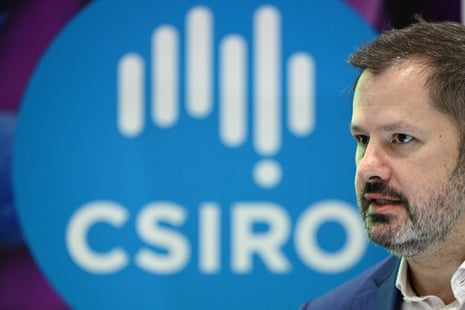New chief executive will have their work cut out for them after what some scientists call ‘painful’ change under Larry Marshall.

Sun 20 Nov 2022 06.00 AEDT
Last modified on Sun 20 Nov 2022 11.01 AEDT“The organisation was changed profoundly under his leadership,” one senior scientist told Guardian Australia about Marshall’s term that began in 2015. “It was painful.”
Ed Husic, the industry and science minister, was more positive, thanking Marshall for steering the Commonwealth Scientific and Industrial Research Organisation “through a rapidly changing scientific environment [marked by] much scientific promise amid global turbulence”.
CSIRO tallied Marshall’s achievements, including “inspiring school children with physics experiments, pulling yet another piece of amazing science from his pocket, creating start-ups from science [and] fiercely defending the integrity and trust of the organisation”.
Marshall’s tenure as CEO, the longest in half a century, had its controversies. Early into his role in 2016, he announced plans to slash CSIRO’s climate research division. Intervention by the then environment minister Greg Hunt stemmed job losses but even his $37m 10-year plan to study near-term climate change has lately been axed.
Perhaps more lasting, though, has been Marshall’s push for the agency to generate more money from research. The recent revelation of a “significant” new working model to promote commercial deals sparked disquiet from Husic’s office, with a spokesperson saying the minister looked forward “to being consulted on important changes”.
Marshall’s exit, though, offers Labor a rare opportunity to alter CSIRO’s direction. The relative emphasis of science or industry has shifted over the past century – a 1926 act created the Council for Scientific and Industrial Research – and the Albanese government can tip the scales if it wants to.
An indication of its intent will come when Husic presents the government’s statement of expectations for CSIRO, most likely in the new year. There are also two non-executive director slots to fill on the agency’s 10-member board.
And while the board formally operates independently, it must consult with the minister about key appointment including the next CEO. The choice of Marshall followed rejections of multiple candidates by the Coalition government under Tony Abbott, insiders say.
The Greens senator Janet Rice, a critic of the Marshall era and whose late partner was a leading CSIRO climate scientist, said the government had a chance to recommit to science that was in the national interest even if it didn’t generate immediate income.

During recent Senate estimates, Rice managed to extract a concession from CSIRO executives that scientists proposing projects had to secure at least 70% of funding from external sources. (That proportion excludes overhead costs that typically run to $600m or more a year, a senior researcher tells Guardian Australia.)
“Australia was absolutely at the world’s forefront of climate science – and now we’re not,” Rice said. “It’s tragic … you can see the decline in scientific expertise.”
The 70-30 split on external and internal funding “puts the kibosh on so much public-good science”, she said.
Rice said the type of CEO likely to be attracted to run CSIRO would hinge on the signals the government sends about its commitment to science or commerce. If it is more supportive of the former, it would also need to increase funding.
The scientist who described the Marshall era as painful said CSIRO’s priority should be to address market failures where benefits of investment were not yet known. (One of CSIRO’s most famous inventions, wifi, emerged from radioastronomy.) It should also be wary about shopping out the brand to operations such as gas extraction or deep-sea mining. Such ventures did not need subsidised science.
This researcher also predicted the new CEO would review current operations, some of which had been loss-makers. These included forays into California’s Silicon Valley, Hanoi in Vietnam and Indonesia’s Jakarta.
A CSIRO spokesperson said the US office was moved from Silicon Valley to San Francisco to co-locate with Team Australia which includes Telstra, Austrade and the Victorian and Queensland state governments. South-east Asia, too, remains a priority.
“We revise our global footprint and strategy regularly to account for a range of factors including changed global circumstances,” the spokesperson said.
Staff had also been warned about signing deals such as a $20m partnership with billionaire Andrew Forrest’s Fortescue Metals Group that handed over five years of exclusive use of a membrane technology allowing hydrogen to be converted to ammonia and back again. “We’re told, ‘don’t make it another Fortescue’,” this senior scientist said.
CSIRO was approached for interviews. A spokesperson provided links to CSIRO’s 1949 act and its latest corporate plan. Fortescue declined to comment.
The CSIRO Staff Association, meanwhile, has raised concerns about the poor morale in the organisation, particularly within areas such as the oceans and atmosphere division.
That group has lately been merged with land and water, creating a new environment business unit, CSIRO’s largest. The union has complained about the lack of consultation.
“They keep stating CSIRO is full of super-smart brains committed to solving Australia’s biggest problems, but consulting them about their work is beyond their capacity,” one insider said. “It doesn’t make sense.”
The person also pointed to CSIRO’s ongoing issues – including pay “suppressed by the previous government” – making it harder to attract new talent.
CSIRO’s new recruitment campaign “Impossible without you” has its work cut out, he said. Likely, so will the new chief executive.
No comments:
Post a Comment